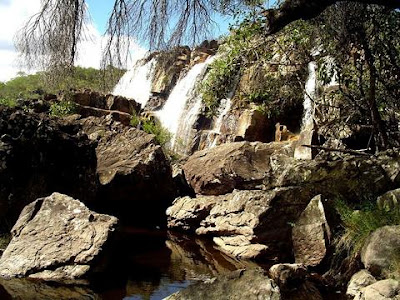Brazil's Chapada dos Veadeiros National Park is located in the Chapada dos Veadeiros, an ancient plateau with an estimated age of 1.8 billion years. Based in the Brazilian state of Goias, the Park was created on January 11, 1961 by President Juscelino Kubitscheck, and listed as a World Heritage Site by Unesco in 2001. It occupies an area of 655 square kilometres and is maintained by IBAMA.
Geography
Climate
The average yearly temperature is 24-26 degrees Celsius, ranging from a minimum of 4-8 degrees Celsius and reaching a maximum of 40-42 degrees Celsius.
Altitude
With altitudes between 600 and 1650 meters, it is the highest plain in Central Brazil. The highest point of the park and of the state of Goiás is Serra da Santana, at 1691 meters above sea level.
Rock formations
Its rock formations are one of the oldest on the planet. There are quartz with outcrops of crystals. These rocks are exported and appreciated in Japan and England, where for some decades they were used for industrial work. Nowadays therapists and nature lovers seek energies and the power to cure from the crystals and from places like Alto Paraiso. Rock crystals are present in the soil of the rich Cerrado, or open pasture. Forest growth is also still found in the region, where more than 25 species of orchids can be found, besides other Brazilian species such as Pau d'Arco Roxo, Copaíba (Copa Tree), Aroeira (California pepper tree), Tamanqueira (Cork Tree), Jerivá (a variety of Palm Tree), Buritis (Wine-palm) and Babaçu (Babassu). The main river in the park is the Rio Preto, a tributary of the Tocantins River. Along its course, there are many waterfalls, such as the Rio Preto Falls (120 meters high, 80 meters at the base) and the Cariocas Falls. The canyons are just as beautiful, with walls of up to 40 meters high and valleys of up to 300 meters.
List of waterfalls
In the National Park there are the 120 m Waterfall, the 80 m Waterfall, the Corredeiras, Cannyon I, Cannyon II, the Carioquinhas Waterfall and the Jardim de Maitréya. In properties with controlled access: Águas Quentes, Morada do Sol, Banho das Crianças and Vale das Andorinhas, Salto do Raizama and Cannyon do Rio São Miguel, Vale da lua, Cachoeiras Almécegas I and Almécegas II, Cachoeira de São Bento, Cataratas do Rio dos Couros, Cachoeira do Rio Cristal, Cachoeira dos Anjos e dos Arcanjos, Água Fria, Cachoeira do Rio das Almas, Poço Encantado, Sertão Zen, Cachoeira do Rio Macaco, Território Kalunga, Lago Serra da Mesa, Bocaina do Faria, Cachoeira das Neves, Mirante do Pouso Alto, Alpes Goianos, Cachoeira do Santana, Cachoeira da Ave Maria, Morada do Sol, Pedra Escrita, Cachoeira das Pedras Bonitas, and Ponte de Pedra.
The local fauna
The rich fauna of the region includes species threatened by extinction such as the pampas deer (locally known as veado campeiro), marsh deer (cervo do pantanal), maned wolves (lobo guará), jaguar, and others like the rhea (ema), seriema, tapeti, giant armadillo (tatu canastra), anteater (tamanduá), capybara (capivara), tapir (anta), green-beaked toucan (tucano de bico verde), black vulture (urubu), and the king vulture (urubu rei).
Many endangered species are found within the park's boundaries, such as the maned wolf, capybaras, rheas and others.














